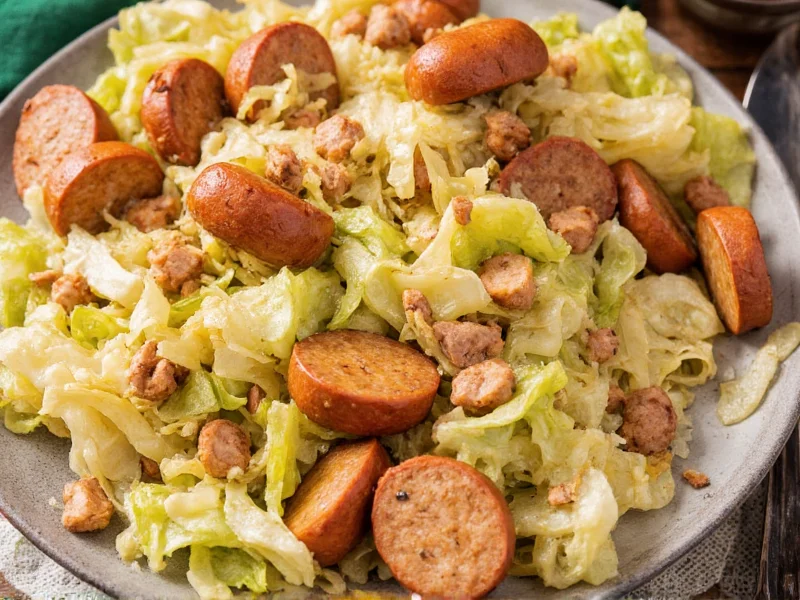Why This Fried Cabbage and Sausage Recipe Works
Traditional in German, Polish, and Eastern European cuisines, this humble combination creates a surprisingly sophisticated flavor profile. The natural sweetness of slowly cooked cabbage balances perfectly with the smoky, savory notes from quality smoked sausage. Unlike many online versions that drown the vegetables in oil, our tested method uses just enough rendered sausage fat to enhance flavors without making the dish greasy.
Essential Ingredients for Authentic Flavor
Quality ingredients make all the difference in this simple dish. Don't substitute unless absolutely necessary:
| Ingredient | Quantity | Why It Matters |
|---|---|---|
| Smoked sausage (kielbasa) | 1 lb (450g) | Provides deep smoky base; avoid fresh sausage which lacks flavor complexity |
| Green cabbage | 1 medium head (2 lbs) | Sweetness develops when cooked; red cabbage works but changes color |
| Yellow onion | 1 large | Adds aromatic foundation; sweet onions work but lack depth |
| Apple cider vinegar | 2 tablespoons | Essential bright note that cuts richness; don't substitute white vinegar |
| Bay leaf | 1 whole | Subtle herbal note that complements smokiness; dried thyme works too |
Step-by-Step Cooking Instructions
- Prep ingredients: Slice sausage into 1/4-inch rounds. Quarter cabbage, remove core, and slice thinly. Chop onion.
- Render sausage fat: Heat large skillet over medium heat. Cook sausage 5-7 minutes until browned, turning occasionally. Remove sausage, leaving 2 tablespoons fat.
- Sauté aromatics: Add onions to skillet. Cook 3-4 minutes until translucent. Add garlic and cook 30 seconds until fragrant.
- Cook cabbage: Add cabbage and 1/4 teaspoon salt. Stir to combine. Cover and cook 10 minutes, stirring once.
- Finish dish: Uncover, add sausage back to skillet, plus bay leaf and vinegar. Cook uncovered 5-7 minutes until cabbage reaches desired tenderness.
- Season: Remove bay leaf. Season with black pepper and additional salt if needed.
Pro Tips for Perfect Results Every Time
Avoid these common mistakes that ruin otherwise good fried cabbage and sausage recipes:
- Don't overcrowd the pan: Cook in batches if necessary. Too much cabbage steams instead of sautés.
- Control moisture: If cabbage releases excess liquid, increase heat to evaporate it quickly.
- Timing matters: For tender-crisp texture, cook cabbage 15-18 minutes total. For softer texture (traditional style), cook 20-25 minutes.
- Acid balance: Add vinegar at the end to preserve its bright flavor. Lemon juice works as substitute.
Delicious Variations to Try
This basic fried cabbage and sausage recipe adapts beautifully to different tastes and dietary needs:
- German-style: Add 1 tablespoon caraway seeds with onions and substitute beer for half the cooking liquid
- Spicy version: Include 1 diced jalapeño with onions and use andouille sausage instead of kielbasa
- Vegan option: Use smoked tofu or seitan with smoked paprika, and vegetable broth instead of sausage fat
- Meal prep friendly: Double the recipe and store portions for up to 4 days; reheats beautifully in skillet
Serving Suggestions and Storage
This versatile dish works as a complete meal or side. For a balanced plate:
- Pair with crusty bread and a simple green salad for a complete dinner
- Serve alongside roasted potatoes for a hearty weekend meal
- Top with a fried egg for a satisfying brunch option
Store leftovers in an airtight container in the refrigerator for up to 4 days. Reheat in a skillet over medium-low heat with a splash of water to refresh the texture. Freezing is not recommended as cabbage becomes mushy when thawed.
Frequently Asked Questions
Can I use frozen cabbage in this fried cabbage and sausage recipe?
While fresh cabbage yields the best texture, you can use frozen cabbage in a pinch. Thaw completely and squeeze out excess moisture before cooking. Expect slightly softer texture and reduce initial cooking time by 3-5 minutes since frozen cabbage has already released some water.
What's the best sausage for cabbage and sausage skillet?
Smoked kielbasa provides the most authentic flavor for traditional fried cabbage and sausage recipes. Other excellent options include smoked bratwurst, andouille for spicy version, or smoked turkey sausage for a lighter option. Avoid fresh sausages as they lack the necessary smoky depth.
How do I prevent my cabbage from becoming mushy?
To maintain perfect texture in your cabbage and sausage recipe, don't overcook the cabbage. For tender-crisp results, cook covered for 10 minutes then uncovered for 5-7 minutes. If using a very large head of cabbage, increase heat slightly during uncovered cooking to evaporate excess moisture. Adding vinegar at the end also helps maintain structure.
Can I make this recipe in an Instant Pot?
Yes, you can adapt this easy fried cabbage and sausage recipe for Instant Pot. Sauté sausage first using "Sauté" function, remove, then sauté onions. Add 1 cup broth, cabbage, and 15 minutes on high pressure. Quick release, return sausage to pot, and add vinegar. Note that texture will be softer than stovetop version.
What are good side dishes for cabbage and sausage?
This one pan cabbage and sausage dinner pairs perfectly with crusty bread to soak up juices, roasted potatoes, or a simple green salad. For a complete traditional meal, serve with boiled potatoes and applesauce. The dish also works well as a side to roasted chicken or pork chops.











 浙公网安备
33010002000092号
浙公网安备
33010002000092号 浙B2-20120091-4
浙B2-20120091-4